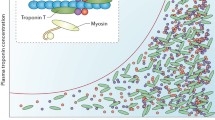Abstract
Troponin levels are commonly employed in the assessment of adults presenting with chest pain or concern for coronary ischemia. However, the utility of troponin measurements in children is not well defined. The purpose of this study was to review the use and clinical yield of serum troponin assay in a large pediatric emergency department (ED). We identified all patients <22 years of age, not previously known to have cardiac disease, who presented with chest pain and whose troponin levels were evaluated in our pediatric ED during a 7-year period. Test results were correlated to patient factors, such as chief complaint, cardiac history, diagnostic workup, and discharge diagnoses. Of the 212 study patients who presented with chest pain, troponin levels were increased (≥0.1 ng/ml) in 37 (17%) subjects. The disposition for these 37 subjects included transfer to adult facility (n = 6), admission to our pediatric inpatient service (n = 27), and discharge to home from the ED (n = 10). Only one subject had an acute myocardial infarction. For those with increased troponin level, 18 of 37 (48%) cases were attributed to a primary cardiac diagnosis with the most common discharge diagnosis of myocarditis or pericarditis. In the pediatric ED setting, selective use of troponin assay may be a useful test in the management of patients with chest pain. Most cases of increased troponin level related to chest pain represent myocarditis, often mild and self-resolving. Given the low likelihood that acute coronary syndrome is the etiology of chest pain, immediate transfer to an adult facility for the majority of patients with increase of troponin does not appear warranted.


Similar content being viewed by others
References
Christ M, Popp S, Pohlmann H, Poravas M, Umarov D, Bach R et al (2010) Implementation of high sensitivity cardiac troponin T measurement in the emergency department. Am J Med 123(12):1134–1142
Desai A, Patel S, Book W (2005) “Myocardial infarction” in adolescents: do we have the correct diagnosis? Pediatr Cardiol 26(5):627–631
Drossner D, Hirsh D, Sturm J, Mahle W (2011) Cardiac disease in pediatric patients presenting to a pediatric ED with chest pain. Am J Emerg Med 29(6):632–638
Freixa X, Sionis A, Castela Á, Guascha E, Loma-Osorioa P, Arzamendia D et al (2009) Low troponin-I levels on admission are associated with worse prognosis in patients with fulminant myocarditis. Transplant Proc 41(6):2234–2236
Freund Y, Chenevier-Gobeaux C, Bonnet P, Claessens YE, Allo JC, Doumenc B et al (2011) High-sensitive versus conventional troponin in the emergency department for the diagnosis of acute myocardial infarction. Crit Care 15(3):R147
Hirsch R, Landt Y, Porter S, Canter CE, Jaffe AS, Ladenson JH et al (1997) Cardiac troponin I in pediatrics: normal values and potential use in the assessment of cardiac injury. J Pediatr 130(6):872–877
Jolly S, Shenkman H, Brieger D, Fox K, Yan A, Eagle K et al (2011) Quantitative troponin and death, cardiogenic shock, cardiac arrest and new heart failure in patients with non-ST-segment elevation acute coronary syndromes (NSTE ACS): insights from the global registry of acute coronary events. Heart 97(3):197–202
Keller T, Zeller T, Peetz D et al (2009) Sensitive troponin I assay in early diagnosis of acute myocardial infarction. N Engl J Med 361(9):868–877
Kern J, Modi R, Atalay M, Kochilas L (2009) Clinical myocarditis masquerading as acute coronary syndrome. J Pediatr 154(4):612–615
Laissy JP, Hyafil F, Feldman L, Juliard JM, Schouman-Claeys E, Steg P et al (2005) Differentiating acute myocardial infarction from myocarditis: diagnostic value of early- and delayed-perfusion cardiac MR imaging. Radiology 237(1):75–82
Mahle W, Campbell R, Favaloro-Sabatier J (2007) Myocardial infarction in adolescents. J Pediatr 151(2):150–154
May L, Patton D, Fruitman D (2011) The evolving approach to paediatric myocarditis: a review of the current literature. Cardiol Young 21(3):241–251
Ohman E, Armstrong P, Christenson R, Granger C, Katus H, Hamm C et al (1996) Cardiac troponin T levels for risk stratification in acute myocardial ischemia. GUSTO IIA investigators. N Engl J Med 335(18):1333–1341
Author information
Authors and Affiliations
Corresponding author
Rights and permissions
About this article
Cite this article
Brown, J.L., Hirsh, D.A. & Mahle, W.T. Use of Troponin as a Screen for Chest Pain in the Pediatric Emergency Department. Pediatr Cardiol 33, 337–342 (2012). https://doi.org/10.1007/s00246-011-0149-8
Received:
Accepted:
Published:
Issue Date:
DOI: https://doi.org/10.1007/s00246-011-0149-8




